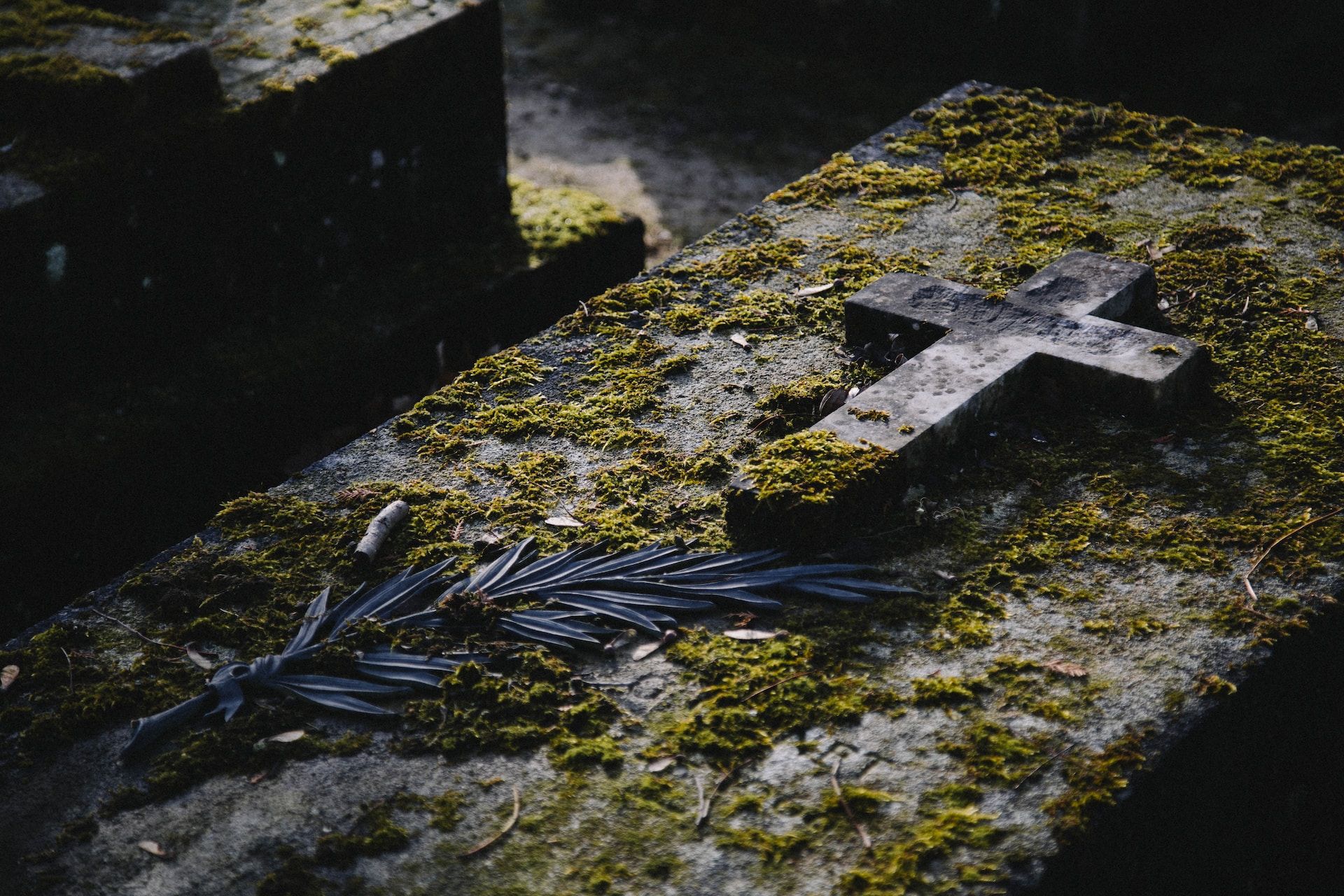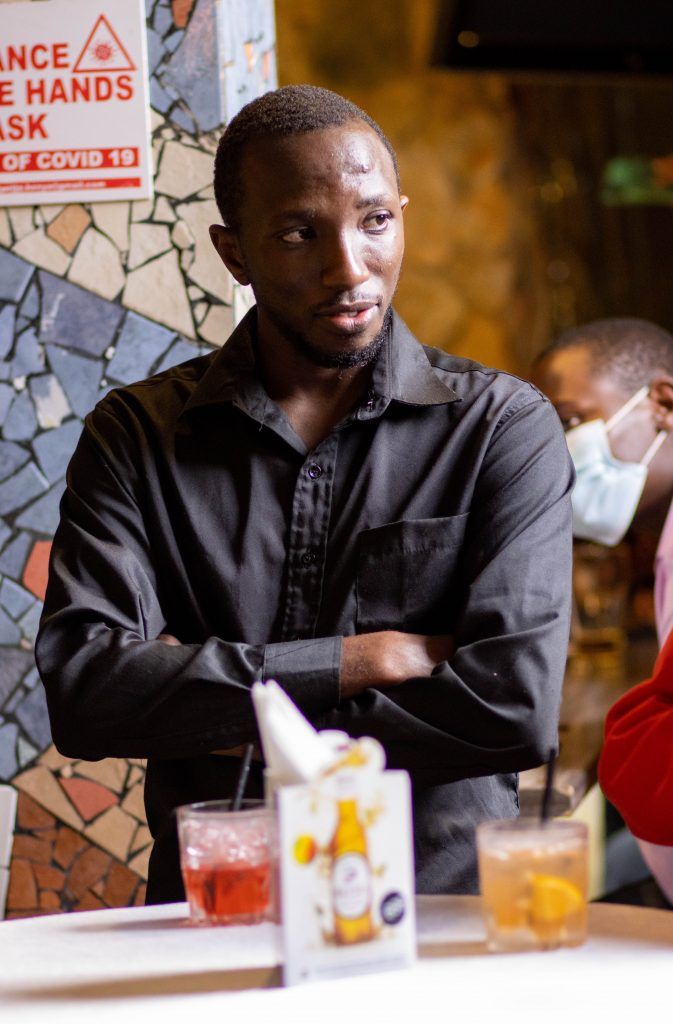“She is victorious,” the pastor at the funeral remarked, microphone in hand, her voice bearing the stern authority only staunch believers can muster.

I was seated in the last row of the middle tent, silently shivering in the unforgiving July cold. Victorious? I wondered. I know we say Christ is victorious. He rose from the dead and thereby conquered death. But that is Christ. Some things believers say stagger me. If death is a victory, defeat was never more attractive, I mused.
But their conviction unsettled me. Why were they so at ease and confident? So triumphant. What gave them this authority, this utter lack of fear in the face of that last enemy?
A brief history of death
My search for answers sent me to the internet. In a previous article, I suggested the Google search engine, with its omniscience, is a god of our own making. To these great tech gods did I turn for answers. On TikTok, I discovered accounts run by professional morticians. It was a shock, the popularity of morticians’ content. Perhaps we are all curious about death. We went to space, explored the seas, probed our brains, investigated subatomic particles, but death remains a great mystery, the last frontier.
On a hot August afternoon, I strolled to the library. I said to the librarian, “I want books on death and funerals.” But there were none. I wanted to investigate the beliefs different cultures and ages held about death.
To be fair I did find one book meant for children which contained information about cremation in India, the double burials of the Iroquois Indians, the burial practices of the Maoris, the Navajo Indians, the ancient Egyptians and others. Some communities were terrified of death. Some honoured it. Some did not bury their dead. Some dispatched the remains to the underworld accompanied by presents. Some showered the bereaved with gifts. Some sailed the corpse out on a boat laden with the deceased’s belongings and set the boat on fire.
Taboos fascinated me. These more than anything else gave information on the attitude of a people towards death. They were expressions of fear. In Anthropology Made Simple, John Lewis writes: “The function of taboo is predominantly psychological, originating in Man’s fear of dealing with forces he does not wholly understand.”
Contact with a corpse among the Kikuyu made one unclean, necessitating purification. The law of Moses similarly decreed, “whosoever is unclean by the dead, both male and female, shall be put out, without the camp shall ye put them; that they defile not the camp, in the midst whereof Jehovah dwells.” At Roman funerals, all participants were sprinkled with water and compelled to step over a fire.
In a time of comparatively underdeveloped knowledge and technology, people tackled the great mysteries of the universe through ritual, taboo, mysticism, superstition and religion. In most African communities the land of the dead seemed to coexist with the land of the living. The ancestors were never too far from the living and were frequently called upon to participate in contemporary affairs. Their blessings and approval were constantly sought through offerings, sacrifices and libations. Death was accepted as part of life. It was not the end. It was a gateway to becoming one of the revered ancestors. Not all spirits were benevolent however; witchcraft and magic were common.
I am reminded of a Christian saying: ‘this world is not our home, we are only passing through on our way to a better place’.
Could it be religion was invented to aid humanity in withstanding the unbearable anxiety of the inevitability of death? Christianity for instance came into existence only after the execution of Christ by crucifixion. The death and resurrection of Christ is a foundational aspect of that religion. Christians claim that after dying, we fall asleep and shall only awake on the day of judgement when Jesus returns and the dead shall rise and some shall go to heaven and others shall be cast into the lake of fire with their father, the devil.

Eastern religions claim death is not the end but part of an ouroboric cycle. After dying, you are born again in a new body, a process meant to recur endlessly until you attain enlightenment. Rebirth is in a sense punishment for failure to cleanse yourself from sin and desire during your lifetime. The optimal state is nirvana, the attainment of true peace, a cessation of desire, devoid of attachment and suffering, liberated from birth and death. A person who attains nirvana in his lifetime is not reborn, they simply die.
Jesus famously remarked: “Truly, truly I say unto you, unless a grain of wheat falls into earth and dies, it remains alone; but if it dies, it bears much fruit.” A prophecy of his own death and of the rise of the religion in his name. As a proverb, it is applicable to revolutions in general. Popular movements, it appears, must be watered by the blood of martyrs – almost as if the ideas they fight for require a blood sacrifice to guarantee immortality. Christians like St Paul rejoice when they are persecuted and killed, rightfully believing their suffering is necessary for the glorification of the gospel.
We should not be overly astonished by the appeal of the Shakahola death cult. Isn’t their doctrine of death and sacrifice in a sense identical to the doctrines pronounced in the New Testament, particularly by Paul (who seemed more than a little obsessed with the cross as a metaphor for salvation through the death of one man)?
Terrorist groups like Al Qaeda justify their violence by invoking the term jihad, holy war. Those who die waging jihad will be richly rewarded in the afterlife, their doctrine dictates. I am reminded of a Christian saying: this world is not our home, we are only passing through on our way to a better place. The jihadist receives a heavenly reward for waging an earthly war. Perhaps you can see the correlation between this ideology and the pastor at the funeral in my first paragraph upholding the deceased’s departure as a “victory”. The term victory has a connotation of struggle, competition, war … holy war?
Ngugi wa Thiong’o is a Kenyan novelist and intellectual who in his work about Mau Mau and in his ideological war against the forces of imperialism emerges as something of a priest. His books frequently feature religious figures, ceremonies and rituals, both Christian and Gikuyu. His writings possess the fervour of an inspired missionary and he is obsessed with martyrs. Fittingly, one of his books is titled Grain of Wheat and is based on the concept we ascribed to Christ: revolutions that endure are watered by the blood of martyrs.
What is it about the sacrifice of martyrship that sustains movements and their ideologies? As if the masses are reluctant to respect ideas no one has died for. As if ideas are doomed to remain theoretical until someone grounds them by offering up his life in their defence. Is there a correlation with the morbid logic governing the concept of human sacrifices in pre-Christian societies? When the rains kept away too long, a child was offered up as a sacrifice and apparently abundant rainfall would follow. Is death then an ingredient of powerful ritual and magic? Countless goats and bulls have been slaughtered over the millennia for ritualistic not culinary ends. Is there credence to the conspiracy theory claiming the Shakahola death cult was a mass sacrifice? A dark magic ritual encompassing human sacrifice at an obscene scale.
Death entered the world when Adam and Eve partook of the forbidden fruit. Significantly, the fruit was from a tree of knowledge. Specifically the knowledge of good and evil. What does this signify? Is there a correlation between death and the knowledge of good and evil? Does this give an insight into our morbid fascination with serial killers and mass killers? When we binge on Hitler or Idi Amin documentaries, are we trying to understand death or evil – or both?
People who recoil from death’s inevitability suffer when it comes to their doorstep. It breaks them.
We are aware anyone over-sheltered from reality is vulnerable. Anyone who fails to internalise the inevitability of death will be caught flatfooted. Anyone unprepared to encounter the reptilian spirit that is evil in humans is vulnerable. Not unlike Adam and Eve. Good and evil were put in our hearts on partaking of the fruit – alternatively, eating the fruit awakened humanity’s capacity for good or evil. One capable of one extreme is equally capable of the opposite extreme, a paradox demonstrated by King David and other fallen heroes, redeemed villains.
Death in the family can destabilise us. Those who lack knowledge it will destroy. The inability to accept the inevitability of death is dangerous. It is the hidden engine of the thriving cosmetic industry. Desperate masses in a superficial era fighting the inevitable, the atrophy of the body, the sagging of body parts, the decay, as our hourglasses run out of sand.
One unfortunate outcome of this inordinate worship of youth is the collective disgust at old age, the despising of elders. The youth are esteemed for being fashionable, trendy, and innovative. In politics, this manifested a decade ago as “digital vs analogue”, an ageist ideology that compels ageing politicians to indulge in cosmetics and plastic surgery to save themselves from public ridicule. A stark contrast to our ancestors who understood death and ageing are the way of all life, and they honoured the dead, respected the aged.
People who recoil from death’s inevitability suffer when it comes to their doorstep. It breaks them. It breaks others as well – love overwhelms us, understandably. Letting go is easier said than done. It might be why great literature so often has death as its subject. To acclimatise us to this truth, to prepare us, to imbue us with this precious knowledge, that we may be prepared for the uninvited guest. The great Greek tragedies and the tragedies of Shakespeare are considered the finest classics of the Western canon. Chinua Achebe’s Things Fall Apart is a tragedy. All of Ngugi’s early great novels were tragedies.
Reading Weep not Child as a twelve-year-old was devastating. But I read it repeatedly. Why are so many children obsessed with the Harry Potter series, despite the many deaths of beloved characters? Why are folk tales universally beloved despite their harsh, tragic storylines? Children are desperate for knowledge. Stories that scare them may seem to us traumatic but are to them sources of knowledge. Like Adam and Eve, our children are thirsty for the knowledge of good and evil, and of life and death. An epic like Harry Potter introduces them to these two twin truths. They learn that evil, while scary, can be fought – by ourselves, puny as we may be! Courage – a quality we must imbue in the next generation if there is to be any hope for us. The story also teaches them that unbearable as it is, death can be endured and overcome.
The pastor declared the deceased was victorious but in truth, it is we left behind who must become victorious through our endurance and ability to recover from grief. In his book Beyond Order, Prof Jordan Peterson writes: “The human race has been dealing with loss and death forever. We are the descendants of those who could manage it. That capability is within us, grim as the task might seem.”
Yet after everyone has left, the family is left alone and an unbearable loneliness that is sorrow descends on the home.
Funerals are a platform for society to stand in solidarity with the bereaved. To strengthen their courage and endurance in a time of darkness and confusion. I am proposing, in addition, a hidden role of funerals: to dispense precious knowledge to the living. The very same knowledge we seek in tragic literature. A reminder that death is inevitable, inescapable. Solomon famously declared his preference for funerals over weddings – his eagerness for wisdom bordered on gluttony. He was on to something though. People are on the whole more admirable in their conduct at funerals. As if the reality of death fleetingly awakens us to what is vain, what is substantial.

On the value of communal occasions such as funerals, John Lewis writes: “In these activities, men are bound together socially; man is raised above himself and is made to lead a life superior to that which he would lead if he followed only his individual ideas. Beliefs and myths express his life in symbolic form; rites organise it and regulate its working. The ceremony gives collective expression to the social sentiments of an organised community. These are affirmed, strengthened, and renewed by rites.”
At the funeral, I was conscious of being enveloped by a warm blanket of social support. The genuineness of people’s smiles. The pleasure of meeting so many family members at the same place, some I had not seen in decades. In this the deceased was certainly victorious, bringing the family together.
Yet after everyone has left, the family is left alone and an unbearable loneliness that is sorrow descends on the home. Prof Jordan Peterson: “Grief must be a reflection of love. It is perhaps the ultimate proof of love. Grief is an uncontrollable manifestation of your belief that the lost person’s existence, limited and flawed as it might have been, was worthwhile, despite the limitations and flaws even of life itself.”
Somehow my thoughts wander to the ancient Egyptians. Is it in order to define the pyramids as monuments of grief? Were they not the exalted tombs of Khemet’s monarchs? When the pharaoh died, his royal corpse was treated with spices, herbs and chemicals to preserve the flesh. The body was subsequently wrapped in layers of cotton cloth and the mummy placed in a king-befitting wooden case which was sealed in a vault of stone.
The Egyptians would also put to death the dead king’s slaves for their master would require their service in the spirit world. Additionally, the tomb was supplied with food, tools, chariots and thrones – as if the pharaoh was going to wage war and conquer territory to rule over in the world of the dead.
Was grief the Egyptians’ motivation to build these extravagant monuments? Was grief the inspiration of the ancient Greeks and Romans to deify dead kings and heroes? Was it grief that moved our ancestors to deify their ancestors and hold on to them through a system of rituals and taboos? Were the disciples of great prophets moved by their grief after the prophets’ deaths to develop religions in their remembrance? Is the immortality of heroes nothing more than a desire to keep alive the qualities and essence of great men?
Could this be why biographies exist? And why the sayings of the great dead are recorded, giving rise to religions and schools of philosophy? Are death, grief and our refusal to let the dead be forgotten the driver of so much from religion to revolution, literature, art, tradition and so much else? Isn’t the structure of society itself built upon this foundation?

What doesn’t kill you…
Could death be in some sense the foundation of all knowledge? Adam and Eve remained ignorant as babes until they partook of the aptly named tree of the knowledge of good and evil. One might argue we remain ignorant about the afterlife right until death – in that sense, dying is an awakening rather than a falling asleep. You fall asleep in this world to awaken in the next. It is not impossible to conjecture all knowledge as originating from man’s fear of the inglorious inevitable. Due to this inherent anxiety, we invented religion, philosophy, society, government, housing, medicine, clothing, astronomy and so forth as either physical or psychological protection.
The demise of religion (or as one philosopher Nietzsche puts it, “the murder of God”) coincided with the exponential advancement of knowledge and technology.
In the ages of antiquity, mathematics and astronomy complemented each other. Both were born from man’s desire to organise reality into an ordered system as a defence against chaos – put simply, for fear of arbitrary death. Due to the anxiety caused by the randomness of a chaotic world, humans studied the universe hoping more understanding would bestow on them more control over their environment.
We know ancient kings like Nebuchadnezzar kept a battery of astrologers, magicians and wise men to predict the future, interpret troubling dreams and generally soften the royal’s anxiety about sudden death through illness, war or coup. A modern Nebuchadnezzar would surround himself with psychologists, economists, historians and political scientists.
Astrology and astronomy, it is possible, led the wise men to the study and development of geometry and as learning increased, the complexity of knowledge multiplied, leading to the splintering of knowledge into precise fields like calculus, physics, trigonometry and what have you. The demise of religion (or as one philosopher Nietzsche puts it, “the murder of God”) coincided with the exponential advancement of knowledge and technology. Because we are less fearful of the elements of nature than our ancestors, we are less religious, less superstitious.
However, advanced as we are, death itself remains a mystery. Psychologist Jordan Peterson recounts the story of a client who was terrified of existence itself, a young underachieving university student who frequently took sleeping pills that kept her asleep (and therefore away from reality) fifteen or sixteen hours a day. Interestingly, the girl was healed after two remarkable trips.
The first trip, suggested by Peterson, was to the slaughterhouse. It was a difficult experience, sheltered as she was from the realities of life and death, but she tremblingly endured it and from that day registered progress. The second remarkable trip was to the mortuary, a suggestion made by the girl herself. This ties in with my anecdote earlier about my shock at the massive traffic mortician content attracts on TikTok. Like the girl, viewers of this content hunger for knowledge that apparently can only be obtained from the contemplation of death.
Writing about the girl, Peterson remarks, “My client had learned something vitally important about her tolerance for the terrors of life. Equally importantly, she had a reference point for her fears: from that point onward (and I am by no means claiming complete success in her treatment) she had something truly awe-inspiring – something truly serious and horrifying and graphic and real – to compare with the other almost inevitably lesser horrors of life.”
What we are actually desperate for when we consume mortician content is perhaps nothing more but a reassurance that on the day that grim reaper strikes close we will demonstrate sufficient courage and endurance. We crave the strength to withstand the vicissitudes of existence. Looking death in the face, even voyeuristically, it would appear, is our attempt to fortify our spirits, toughen our wills. By exposing ourselves to the terror our imagination rouses in our minds when we think of death, we are, it is possible, vaccinating ourselves against the lesser shocks of existence.
She meditates frequently on what can go wrong in all things. She says this gives her peace.
No one understands this more than rapper 50 Cent according to bestselling author Robert Greene in his book 50th Law. Greene claims 50 Cent’s success stems from his attitude of fearlessness ingrained by the near-death experience of surviving nine bullets. Having survived such a traumatic ordeal, everything else became mundane in comparison – why get butterflies over a boardroom negotiation when you survived nine bullets? The logic is interestingly identical to what Jordan Peterson tells us about his client’s attitude after the mortuary visit.
Yamamoto Tsunetomo, author of Hagakure: The Book of the Samurai, has this to say: “The way of the samurai is found in death. Meditation on inevitable death should be performed daily. Every day when one’s body and mind are at peace, one should meditate upon being ripped apart by arrows, rifles, spears and swords, being carried away by surging waves, being thrown into the midst of a great fire, being struck by lightning, being shaken to death by a great earthquake, falling from thousand-foot cliffs, dying of disease or committing seppuku at the death of one’s master. And every day without fail one should consider himself dead. This is the substance of the way of the samurai.”
A month ago I spoke to an anaesthetist who described her mental preparations for surgery and it was the exact same philosophy Yamamoto Tsunetomo prescribed for samurai. She imagines what can go wrong in graphic detail and prepares accordingly. What started as a method to prepare her for surgery has become her life philosophy. She meditates frequently on what can go wrong in all things. She says this gives her peace.
Traditionally boys became men through an initiation process which required them to conquer their fear. For many communities, circumcision was the preferred route. The Maasai went a step further, requiring a young man to kill a lion as a precondition for becoming a moran. Fans of the movie 300 will remember the epic opening scene: a young Leonidas stalks and kills a ravenous wolf as a necessary step in his preparation to become a king of the Spartans, that nation of fearless warriors.
Perhaps this is the missing link in modern, liberal society with its much-lamented-over crisis of masculinity. I am thrilled by a phrase in 50 Memos for Men: Volume II, the book by Silas Nyanchwani: seven times a man meets himself. It is a tantalising concept: a man meeting himself. A man must meet himself to overcome himself. He must face his fears and weaknesses manfully. He must reject the easy path of self-distraction whose end is ultimately self-destruction. Many men chose escape. In alcohol, porn, casual sex, social media, toys, compulsive workaholism, fantasy…
Ultimately our biggest fear is our own mortality. We remain wanderers like Cain until we come to terms with it. Cain was the first man to see the death of another and the sight of it terrified him. To say nothing of the guilt in his heart for having been the cause of something so terrible. Cain became a wanderer, needing to forget, to escape, to distract himself from himself. In a bid to avoid a meeting with himself, he ran. But everywhere he went he was recognised as Cain the man who murdered his own brother. A man must be ready to meet himself.
Silas Nyanchwani writes:
The first time I met myself, I had just turned 11. It was two days after my mother had been buried and I was staring at the mint-fresh grave, alone but unafraid.
After he rose from the dead, Christ said two significant things to those he appeared to:
- “Do not be afraid.” (Matthew 28:10)
- “Peace be with you.” (John 20:19)
When death appears on our path, in our lives, we meet ourselves. We want to run. Let us remember these words. Fear not. Peace be with you.





